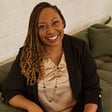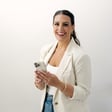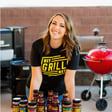Facebook Ad Effectiveness and Audience Reach
00:00:06
Speaker
You cannot make any assessment on an ad if it's been successful or not until you've gotten in front of a couple thousand people. So, you know, I would say like, I have a testing budget mind where, you know, that, Hey, I'm not going to make any changes. I'm not going to really play with this too much until I've gotten in front of, I'd say, you know, 2,500 people, because that'll give you a good idea of potentially some click through rates, looking at, Hey, I've gotten in front of people to see if they're actually going to be doing what I want them to do, whether they're making a purchase opt in or whatever.
Introduction to Brands at Book Show and Facebook Advertising
00:00:37
Speaker
Welcome to the Brands at Book Show, where we help creative, service-based businesses build their brands and find more clients. I'm your host, Davy Jones.
00:00:49
Speaker
In today's episode, we are chatting about different audiences that you can create and target when advertising on Facebook. And one of my till agency partners, Jesse Marcheccio, is here to explore this topic with me. In this conversation, we chat about five different audience or targeting possibilities that you can get started on on the Facebook platform. We cover how to create those audiences within Facebook, considerations when targeting each of those audiences.
00:01:15
Speaker
and where we would recommend starting if you have a limited experience with Facebook advertising. Something that we should have mentioned at the beginning of the episode is the importance of testing. We've seen certain audiences work really well in one account and not at all in another. As with many things, it will likely take a little effort to start seeing consistent results.
00:01:35
Speaker
While we certainly believe that Facebook advertising can produce great results, it's not our intention to make it out to be some sort of magical platform that produces massive results without any effort.
Engagement and Feedback Channels
00:01:46
Speaker
Be sure to check out the show notes at davianchrista.com for the resources we mentioned during the episode. And I want to hear from you. Let me know what kind of content that you'd like to see on the Branchette Book Podcast as we move forward. To leave your feedback, head on over to Davian Christa Facebook page and send us a message. You can also DM us on Instagram at Davian Christa. And that's actually how we got the idea of this topic for this episode is somebody sent us a message about targeting on Facebook.
00:02:14
Speaker
And if you're interested in paid advertising, check out the Till Agency over at Till, T-I-L-L dot agency. Now, onto the episode.
00:02:29
Speaker
All right, welcome back to another episode of the Brands That Book Show.
Deep Dive into Facebook Audiences
00:02:33
Speaker
I've got one of my till partners here, Jesse Marcheccio, and we are chatting Facebook audiences today. So just to give you a little background on how this came up, we put it out there. We ask people all the time for what kind of topics they want us to cover. And somebody mentioned Facebook ads, I think in particular, because they had mentioned that our ads keep on showing up in their feed and they want to know
00:02:55
Speaker
They want to know what kind of targeting we're doing. So Jesse, excited to have you back on the podcast. Yeah, excited to be here and chat Facebook audiences because that's a question that we get all the time too. So I'm sure that I hope that's going to be helpful for a lot of people.
00:03:09
Speaker
Yeah, absolutely. And so just at the outset here, setting some goals for our conversation, and Jesse and I had this conversation a little bit before we turn the recording on, we want to get into some stuff for sure. We also want to keep it simple enough that you can turn this podcast off and implement some of the things you've learned right away.
00:03:27
Speaker
So we're not going to try to go down the rabbit hole too much, but if you get back to us with questions and just follow up comments on the show notes or through Instagram DMs, we will be sure to record as many episodes as we need to on Facebook ads and Facebook targeting and all of that. And actually, we have something fun to announce. We'll be starting a podcast for the Till Agency.
Future Plans and Opportunities with Till Agency
00:03:50
Speaker
So we have a name, I won't share that yet. We don't have a release date. I would say, what do you think? Next quarter, six months maybe?
00:03:57
Speaker
Yeah, I'd say something like that. I'd say don't hold your breath for like something in the very near future. But you know, I'd say before the end of the year, for sure. Maybe. Yeah, absolutely. We're also getting ready to post a few jobs as well. So that might be worth mentioning too. So you can head over to till that agency to check that out. I'm not sure they're not live on our website.
00:04:21
Speaker
yet, but they will be. And then we'll also be sharing across social media when they are live. But we're looking for a few people to fill a few different roles. So if you're interested in paid advertising, marketing in general, let us know.
Understanding Warm vs Cold Audiences
00:04:35
Speaker
Cool. Well, let's dive into Facebook audiences. We're going to focus on five different audiences here. There's certainly overlap between some of these audiences, but I think that the best way maybe to break it down for people, Jesse, is to start with our warm audiences and then move to cold audiences. So can you just talk real quick about maybe the difference between a warm and cold audience?
00:04:59
Speaker
Yeah, for sure. So I think that a lot of people want to define, you know, like a cold audiences, these people, and there's this hard line between what's warm and what's cold. I think that it's more of a spectrum. You know, we look at people that are going to be really hot leads. They're like, you know, they open all your emails, they like and comment on all your Instagram posts.
00:05:17
Speaker
you know their customers of yours multiple times multiple purchases and then we have on the other side people that have never heard of you before and in the middle of that you have people that are come across your brand one time to time maybe they met you in person maybe they come by your store they bought something from you you know a long time ago and it's something that's very fluid so you have people that were once really hot that you know get colder and colder and colder that we try to warm back up and so with that said from a facebook perspective
00:05:41
Speaker
when we're talking warm audiences, it's the loose definition we like to use. It's people that have been exposed to your brand before and they have heard of your brand. It's not something where they see an ad. They're like, oh, I've never seen this before. It's people that are at least have been exposed to your business name, your product, potentially you as a person, some way in some manner they are familiar with your products or your business, your brand as a whole.
Using Facebook Pixel and Email Lists
00:06:07
Speaker
Then the cold audience is just the opposite of that. People that are
00:06:10
Speaker
Not familiar with you or your brand never heard of you before that would probably be the coldest but again, that's something that's going to be pretty fluid and gradual across that entire range from a facebook perspective working have audiences that were essentially retargeting people that have been a part of your business in one way or another in the past.
00:06:28
Speaker
Yeah, absolutely. As Jesse said, I think one of the biggest takeaways there is that it is a spectrum. There's going to be people who are warmer leads and then those who, of course, are people in audiences that are super cold who have never heard of you from before.
00:06:44
Speaker
even somebody who just signed up to your email list, right may have previously never heard of you before. So even though they're on your email list, they just signed up, they're still pretty cold in a lot of ways. So we're going to dig into those audiences. One thing that we absolutely have to talk about though, before we even talk about this very first warm audience is how we're going to create these audiences.
00:07:04
Speaker
So, again, we'll try not to get into the weeds of the technical aspect of things, but it's worth talking about the Facebook pixel. And I think anytime you talk about tracking codes and pixels, some people get immediately overwhelmed. But I think maybe the best way to describe the pixels is just a script or a piece of code that you put in your website.
00:07:24
Speaker
And it's actually for most website builders out there. And Jesse, I don't know if you would agree with this, but I think most website builders have now made it pretty easy to, you know, inject the pixel show it. I know it's really easy. Squarespace has a, I think a pretty tight integration with Facebook Wix. I'm not so sure WordPress. There's a one of a million plugins you could use to do it. And if you didn't want to use a plugin, it's pretty easy to add that to the, you know, header of your theme. So anything else we should mention about the pixel?
00:07:54
Speaker
I think they're really the only other thing is that when you start using your pixel, it's something that I should say whether or not you plan on using Facebook ads now or potentially in the future. It's a good idea to get that pixel installed as soon as possible because that's going to be collecting data and help all these warm audiences that we're talking about be much more effective right out of the gate than if we just wait until we actually get the ad running.
Creating Audiences from Website Visitors and Social Engagement
00:08:16
Speaker
Yeah, for sure. And I think something else that's worth mentioning, if you were working with an agency on Facebook ads, you should always have them use your pixel, right? So we've run into a couple situations where past clients have worked with other agencies and those agencies haven't used their pixel or they somehow lost access to the pixel that the agency was using. And so all of that data, we're just starting from scratch. So something to keep in mind too, if you can set that up on your own, I think that's always best case scenario.
00:08:43
Speaker
We always tell people as well to set up a business manager account. So if you go to business.facebook.com, it's pretty intuitive to set up. Jesse, I don't know if you have any other details about setting that up, but it connects to your regular Facebook profile so we can see, you know, you can add whatever pages that you already have access to that, you know, out of the gate. Yeah, it should be pretty easy.
00:09:04
Speaker
Yeah, so I think that's all we have to say about sort of the technical aspect of the pixel. But installing the pixel is going to allow you to start gathering data on the people who are visiting your website. So let's talk about probably one of the warmest audiences that you can target. And that's your email list. So Jesse, maybe first walk us through how we would set up that audience to begin with. For sure.
00:09:32
Speaker
So it's relatively easy to do if you have an email list, most email providers will allow you to export your list into a dot CSV file. Once you have that file, you simply go to your Facebook ads manager or business manager and you click on the hamburger icon menu in the top left. You go to audiences and then you'll be able to have an option where you can create new audiences and you have, I think, three options. One is a customer list, one's a saved audience, and one is a lookalike audience.
00:09:57
Speaker
you're going to select a custom audience, and then you'll get a big long list of other things, and you're going to select a customer list. And you'll just upload that list to Facebook, that email list to Facebook, and what Facebook will do is it'll go out and match those emails to Facebook profiles, and then it'll spit out an audience that you can use to target people. So that's going to try to be able to just target people that you're already emailing on a different platform. Yeah, and so why do we consider an email list to be one of the warmest audiences?
00:10:26
Speaker
Yeah, so primarily one, because your email list is typically going to be people that have taken an action, whether it's purchase a product from you or opt into your list. And hopefully, if it's something that you've been keeping up and making sure you have your list at a healthy open rate, click-through rates, it's not something where you email once every six months or a year or something like that, then that might not be the warmest list. But if it's something where you're emailing them on a regular basis, at least I'd say weekly, biweekly, something like that,
00:10:55
Speaker
Those people are going to be pretty exposed to you and your brand, even if they're not necessarily opening all those emails. If they're seeing your name come into their inbox, it's still exposure. It's one of those things where you're not having to necessarily pay for that like you would for other paid advertising like Facebook or Google, any sort of other ads that you may see out there. Given that, we are able to take all of that exposure that you're getting on a weekly basis and
00:11:21
Speaker
you know, put that on a different platform in a different way and just seeing your name is going to catch their eye, seeing your brand, seeing your ad is going to catch their eye. And that's why it's one of the most effective warm audiences and one of the best ways to be able to target, you know, your audience in just a different way and a different platform.
Advanced Strategies for Warm Audiences
00:11:38
Speaker
absolutely. I think it's a great fallback because like you said, even with the email list, and I know we collecting emails is kind of the gold standard as far as leads go, outside of maybe collecting a phone number. A lot of people, at least in the industries that we're working in, aren't following up with phone calls. So email is kind of the way that they're nurturing leads.
00:11:56
Speaker
But besides phone numbers, even email, though, deals with an algorithm, right? We just can't get rid of algorithms. So on Instagram, for instance, we always complain that not everybody sees our posts, you know, so even if somebody likes our page on Facebook, only a small percentage of people will see our post to Facebook.
00:12:12
Speaker
Something is true of email as well. So email service providers like Google, trying to figure out, okay, what messages are promotions, for instance, and that's why some of your messages go to your promotions tab, or some of your messages go to spam, because there are certain indicators that they use this side, this looks like a spam email. So you're always battling with some sort of algorithm. But at the very least with this, you can take this email list, upload it to Facebook, target those people on a different platform,
00:12:37
Speaker
So even if they've gone cold on your email list for whatever reason, maybe you're unfortunately ending up in the spam mailbox, even if you're not spam, then you can target them on another platform. So I think it makes it an extremely effective audience to target.
00:12:53
Speaker
So email list is where we're going to start. We're going to come back to emails in a minute because there's some other maybe more advanced things that we can do with that email list. But the next level of warm traffic that you can target would be your website visitors. So we just talked a little bit about the pixel, but Jesse, can you talk us through how we can
Exploring Lookalike Audiences
00:13:14
Speaker
create a website traffic audience?
00:13:17
Speaker
For sure. So it's very similar to how you create your email list. When you go to create a custom audience, you'll have the opportunity to get your audience. Instead of it being a customer list, we could use a website traffic as the base or the source for that audience. When you click on that, it'll give you a bunch of options. You can create the audience based on people that have visited certain pages on your website over a certain period of time.
00:13:40
Speaker
If you're just creating your first audience, I'd recommend just doing all website traffic across, you know, the max time. So that's usually going to be 180 days. So was that six months? So creating that 160, 180 day audience of anyone who's ever visited your site or any website, any page on your site is going to give you the biggest audience. Now, if you have a massive site that gets a lot of traffic, you may want to segment that a little bit based on people that, you know, visit your blog versus like visit your shop or something like that.
00:14:09
Speaker
But in general, typically just getting started with that first all website traffic over the last six months is usually a pretty good place to start. And just like that, you click save audience and Facebook's gonna gather up all those people and it allows you to target those people, retarget those people at least.
00:14:26
Speaker
Yeah. And occasionally, especially if you're just getting started out, maybe you have a new business that audience might be too small at first to target. So, and the same goes for email lists as well, especially with all the privacy concerns that Facebook's been dealing with, I would say at least in the last what year or two years or so, you know, it's getting a little bit harder, I would say maybe to get detailed with your targeting. And so especially when you're
Detailed Targeting and Algorithm Freedom
00:14:48
Speaker
targeting small groups of people, Facebook is going to push back quite a bit on whether or not you're going to be able to target the audience.
00:14:55
Speaker
But that I think by using the max amount of days like Jesse had suggested using that 180 day window, it'll make it more likely that you'll be able to target those people if you're just getting started. So let's keep moving. Let's talk about the next sort of warm audience that you can consider targeting. And that's your social engagement. So walk us through that.
00:15:15
Speaker
Yeah, so if you have a business page or a business profile on Instagram, now it's important to distinguish between a business Facebook page and a content creator. I'm sorry, Instagram page or Instagram profile. If you do not have a business Instagram profile, you cannot create an audience based on social engagement on Instagram.
00:15:34
Speaker
Can I interrupt to one second just to ask you sort of a question? It's a little off topic, but I think it's going to help people navigate this issue here because a lot of people have not moved. A lot of businesses have not switched their Instagram profiles to be a business profile because they believe that engagement gets harder when that happens. Do you have any thoughts on that? Yeah.
00:15:59
Speaker
personally done a couple tests and I've helped a couple people kind of navigate what that looks like and, you know, looking at their numbers pre versus post. And I think that initially it's pretty proven that you're going to see a little bit of a drop of engagement initially. And I think that that has to do with the fact that when you switch profiles, my guess is that some sort of algorithm gets reset and you're kind of essentially starting from scratch.
00:16:24
Speaker
or at least it resets something that's relearning some things. Then after you continue to post after a couple weeks or something like that, I've seen that engagement gets back to pretty close at least to where it was before.
00:16:38
Speaker
I think that it's a good trade off for what you get in return, all the stats that you get. And the exact same thing happened with Facebook where Facebook pages used to be free. You get a ton of engagement on it. Then they switch it over to, hey, with your page, your organic reach goes down to a max of 2%. And if you want to get in front of more people, you have to pay for it. And we saw the exact same thing happen with Instagram. And my guess is they're going to start forcing more businesses to become business profiles in the future. But I don't think that it's something that's worth
00:17:07
Speaker
holding out unless you have a really good reason, you know, that I'm not aware of. Yeah. And maybe it's just that you have no interest in paid advertising at all. But I think that if you are interested in any sort of paid advertising, certainly advertising on the Facebook platform, which includes Instagram, that you should really consider switching.
Budgeting and Optimization for Facebook Ads
00:17:26
Speaker
Yeah, I agree. And you know, because this audience is, you know, one of our go to audiences for any of our clients that have, you know, any sort of
00:17:36
Speaker
following. I mean, I'm talking just like a thousand or two thousand people. This audience can be a really good audience because it's going to be a very warm, engaged audience just by definition, because how it works is.
00:17:48
Speaker
Facebook takes all the people that have engaged with your Instagram profile or your Facebook profile. My guess is going to be the majority of you listening are going to be interested in that Instagram engagement audience. And so they take all of those people and allows you to get more content in front of them, different offers in front of them, allows you to create an audience of people that are like honestly really engaged with your business because to get on that audience, they had to engage with your profile.
00:18:15
Speaker
Yeah, and so I would say that definitely worth making the switch if you're interested in doing any sort of advertising. I think you also get better metrics too, like sort of a metrics dashboard when you do end up switching to your Instagram personal profile to a business profile. So that's worth exploring as well. I want to talk about these three audiences we just covered, which we consider sort of our warmer audiences. And that's our email list, our website traffic, and our social engagement.
00:18:42
Speaker
and the sorts of things that maybe we should expect from targeting those audiences or the sorts of campaigns that we like to run. For warm audiences, it's a great audience to retarget with an offer because they're probably familiar with that offer. If you're doing a big launch and you're sending emails out about it, it's great to retarget that email list, for instance, with ads. You can do that by doing the things that we had mentioned, such as uploading your email list to the Facebook platform.
00:19:11
Speaker
So it's a great opportunity to get offers back in front of people who are already engaged. Anything else that people should expect from targeting warm audiences?
Beginner Strategies for Facebook Ads
00:19:21
Speaker
Yeah, I think that one thing to keep in mind with warm audiences, depending on the size of your audiences or the organic reach that you have with, whether it's content via SEO, Instagram, or Facebook,
00:19:32
Speaker
these audiences are going to be limited by how many people are actually engaged in your business. So depending on how long you've been in business or how big your organic audiences are, these may be relatively limited and they're not going to be all that scalable if you don't have a big audience to retarget. So that is something to keep in mind just in that you probably can't get by with just warm audiences because one of the benefits of Facebook as one of the biggest strengths that it has is its scalability.
00:19:59
Speaker
to be able to figure out there and get new customers instead of just relying on current customers. But it doesn't mean we can't use these to grow our business as well.
00:20:07
Speaker
Yeah, absolutely. I would say that if you've never done any advertising before, that you might see better results right out the gate, especially as you target these warm audiences, but don't, especially if you're not doing any sort of lead generation to cold audiences. And we're going to start talking about cold audiences here in a second. So we'll get to that. But if you're not trying to expand your audiences at all, like Jesse said, don't be surprised if those results plateau a little bit if you're only focused on those warm audiences.
00:20:34
Speaker
So you can definitely get good results from them, but it's an audience that you're always trying to create, right? We're always trying to get more people to engage with us on social and then maybe go to our website and visit our website and then hopefully continue to go up that ladder and sign up for our email list. And then ultimately, of course, purchase.
00:20:51
Speaker
I want to transition here. We're going to talk about two more audiences that we would consider cold audiences. Again, just to cover or just to reiterate cold audiences or audiences that are just not familiar with our brand or not as familiar with
Final Thoughts on Facebook Advertising
00:21:06
Speaker
our brand. The first one that I wanted to chat about are lookalike audiences. Jesse, tell us what a lookalike audience is.
00:21:14
Speaker
Yeah, so a look like audiences are effectively where Facebook takes an audience like your, you know, like any one of the audiences that we already mentioned, whether it's a customer list, social engagement list, or your email list, they take those audiences as a base and they go out and create essentially a profile of all the people on those lists and they go out and find, you know, at the top 1% of a certain demographic that I'm sorry, a certain location that is most like
00:21:44
Speaker
those people that are already on your warm audience. So, for example, if you're using an email list audience and you want to go, this audience is doing really well and you want to say, oh, I think I want more of those kinds of people, then you create a lookalike audience where Facebook is going to go out and find a lot more people, usually right around, you know, if you're targeting the United States, for example,
00:22:04
Speaker
right around 2.2 million people that are most like your people that are already on your email list. And if you think about that for a second and how accurate Facebook can be with those, it is
00:22:16
Speaker
incredible how much information that they have about us that they can do that so accurately. Yeah, that's very accurate. Yeah. And what's crazy, I think that is so accurate that people will claim that, you know, Facebook is listening to us, right? And they very well might be I know that they've publicly denied that they're like listening to your conversations and then serving you ads that are relevant to those conversations. I think it's more than likely that Facebook just has so much data about us. Because remember,
00:22:42
Speaker
Facebook is everybody signed into their Facebook profile, right? And so as we visit different sites, most sites being pixeled, Facebook is collecting data across, you know, how we behave across the web. And so I think it, you know, all of a sudden, when we've been talking to a friend about a product, and we feel like we haven't brought it up anywhere else, and then we see an ad for that product, it's likely that Facebook just has so much data about us that they're able to serve that ad in a timely manner.
00:23:08
Speaker
I wouldn't discount if they're listening to us. I've done some pretty extensive testing on that. Their algorithm wouldn't need to be near omniscient for them to be able to do some of that.
00:23:22
Speaker
All right. So maybe they're listening, but I think the point stance is that they have even, and especially if they're listening, just an incredible amount of data on us. Yeah. I mean, just nuts. So we have these lookalike audiences. And as Jesse said, we can create lookalike audiences based on any audience that we have already created in Facebook, right? So
00:23:41
Speaker
We can take our email list and actually when you're creating your email list at the end of that process, when you're uploading your email list to Facebook, Facebook will ask you if you want to create a lookalike based on that audience. So then you can go ahead and do that. If you're just getting started, I would say like this is the first time you've ever done it. Just do a 1% lookalike, would you agree? Yeah, 1% lookalikes are great. They're going to have different percentages like, oh, I want to target, oh, you know, one, do I think five or 6%. Just go with the smallest number that's available to you.
00:24:11
Speaker
unless, you know, because that's going to be a 2.2 million person audience if you're targeting the entire United States. And that's typically going to be way more people than you're going to blow through unless you're spending a lot of money. I'm talking thousands of dollars every day.
00:24:25
Speaker
Yeah, and I think that's a really good spot to start. As you get more comfortable with a business manager and ads manager, jumping in and testing maybe different percentages is the way to go. This is probably the first audience you should try. If you have a good base audience that you can use to create a lookalike audience, off of this is a great place to start really trying to target cool audiences, people that haven't heard of your business before.
00:24:51
Speaker
Yeah, absolutely. And especially if you have a customer list, like people who have actually purchased something from you. So even beyond, that would be generally of higher quality even than an email list. Although we have, I've certainly in different tests, sometimes my email list audiences outperform
00:25:08
Speaker
you know, my customer list audiences. And we'll talk a little bit about that as well. So don't want to get in the weeds of that. But back to lookalike audiences, you can create them based on your customer list, based on your email list, you can create it based on website traffic. So any of those audiences that we talked about, you can create lookalike audiences, you know, off of those audiences. Anything else that we should mention about lookalike audiences that we haven't already? Maybe talk LTV a little bit?
00:25:34
Speaker
Yeah, for sure. So there's another kind of look like audience or I should say another like add-on that you can use when you upload any sort of customer list. For example, when you upload your customer list, it'll give you an option to also include an LTV file or an LTV column in that file. So you have like email, name, phone number, and you can submit as much or as little information as you want as long as there's an email on there. You may be able to just upload phone numbers too, I forget, but you need like at least one of those columns. You can also add
00:26:04
Speaker
ltv which is the lifetime customer value how much money they've spent with your business so if they made three purchases at thirty dollars a piece the ltv would be ninety dollars and what facebook does is they take that information and give more weight to the people that have spent more money with you assuming that they repeat customers or they just bought your highest products are your most expensive products.
00:26:26
Speaker
And because typically, those are the customers that we want to go after more and more. And so they do a lot of the heavy lifting for us and use that data to find more of those people that are willing to spend more money than you. And they also, I'm sure, are looking at the difference between, okay, who are the people that are spending less money? Who are the people that are spending more money? And then putting more weight in the people that obviously spend more money.
00:26:48
Speaker
Yeah, and absolutely, I think the first of all, if you're confused by this, then just back up, you know, forget we mentioned it, you can just start with lookalike audiences, right? But for those of you who have customer lists, uploading the LTV is going to help Facebook refinance targeting. Also, whenever you're targeting people, kind of the gold standard of a cold audience, I think is people that have completed whatever conversion you're looking for, right? So if you're trying to get more people to sign up for your email list,
00:27:16
Speaker
creating a lookalike audience based on your email list makes sense. If you're trying to get more people to purchase your product, targeting people who look similar to the people who purchase your product makes sense. So, LTV certainly helps, especially when you're running purchase campaigns. Definitely.
00:27:33
Speaker
So I guess I have one more thing to say about that, but I think we should jump into detailed targeting and then just talk about where we should start with audiences. So we have one more sort of cold audience to talk about. It almost to a certain extent doesn't belong in the cold audience camp because you can use detailed targeting to refine any sort of your other audiences, right?
00:27:57
Speaker
Detailed targeting is like targeting people based on interests, for instance. What are some of the other things that you can do with detailed targeting? Yeah, so there are some interests you can target. It's like, you know, pages that I can Facebook brands that they like brands that they've clicked on. And, you know, a lot of big brands are going to be able to be targeted or a lot of big, you know, interests are going to be able to be targeted. But you can also target certain demographics like, hey, are they a parent of kids?
00:28:21
Speaker
ages zero to two? Are they recently engaged? Are they recently married? They have a lot of different life events that you can also target. There used to be, I think, income levels that you could target. They've been taking away and adding things over the last couple of months. Some of the things that I mentioned may or may not still be there, but there's other ways to do it. You can target people that are an admin of a business page or the creator of a business page.
00:28:46
Speaker
There are a lot of different ways that you can make sure that you're getting in front of the right people. For example, if you target only businesses, if you're business to business, you can make sure that you're getting in front of the right people by making sure that they're at least an admin of a Facebook page. If that's the case, you're weeding out a lot of people who may definitely not be business owners because they're not an admin of a business page, for example.
00:29:08
Speaker
Yeah. And so for detailed targeting, I think one mistake that people typically make when they're first getting started is they just rely on only detailed targeting. And oftentimes true. And they don't maybe choose even in detail targeting an audience that's going to be big enough. So we talked about this issue just with website traffic, for instance, like if you're just getting started, obviously there might not have been enough people to go to your website for you to target those people or to create any sort of lookalike off of those people.
00:29:34
Speaker
But sometimes we get into detailed targeting and we're like, well, you know, I think our ideal customer is interested in these three things. And so we target these three things and the audience ends up being, you know, 10,000 people, let's say. And again, similar to what we said about warm audiences, it's going to be pretty easy to kind of blow through targeting that audience. So if possible, I think that detailed targeting is something that we usually use to refine other bigger audiences. Would you say that's fair?
00:30:02
Speaker
Yeah, for sure. I mean, there is a time in a place where you can use detailed targeting on its own because you're also using demographics, location, age, stuff like that. But it depends on your industry. You may find that there are a ton of different, potentially your competitors that you can target. If that's the case, that could be a great audience for you to target potentially colder audiences.
00:30:25
Speaker
to get in front of some of those people. So it just depends on what's available to you and your business and your industry. But if it's not something where you're finding things that feel like it's a perfect match for you, then yes, it's usually something that you use to narrow in on your audience once you have a base where there's a lookalike audience or a custom audience like the Pixel or our website traffic email list or customer list, stuff like that.
00:30:47
Speaker
So to recap the audiences that we've talked about, and then I want to talk about, I think this is a good conversation to have based on detail targeting, getting into getting super detailed with your targeting versus keeping it wide open and kind of letting Facebook do its thing. But before we do that, just recapping the audience as we talked about warm to cold here, we have our email list, typically a much warmer audience, I would say you could if you have a customer list, that would be even warmer than your email list, of course.
00:31:14
Speaker
customer list, email list, kind of putting that in the same category, your website traffic, social engagement, then you have your lookalikes, which all of those audience we just mentioned, you can create lookalikes based off of. And then we just talked about detailed targeting. So lots of different places to start.
00:31:31
Speaker
One question I want to talk about getting super detailed and targeting versus, you know, keeping it wide open and letting the Facebook algorithm work, kind of your thoughts on that. And then something else I want to talk about is, you know, for people who are listening who may not have a lot of experience with Facebook, or have tried it before and have gotten overwhelmed, where they should even start, like, what audiences do you suggest starting with? What campaigns do you suggest running? So I want to get there as well. But first,
00:31:55
Speaker
Going back to these look like audiences where you have an audience of 2.2 million people potentially or more than that, that sounds like a massive audience, right? I mean, to a certain extent, it is a massive audience. It's a lot of people. And I think in the past, both of us have had the same approach where we try to, maybe we try to zero in on that targeting a little bit more. Lately though, what have you been finding?
00:32:20
Speaker
Yeah, for sure. So to kind of speak to that, I've gone through audiences where I am like, because you can layer these audiences. Well, you can say, oh, they have to be between these ages, you know, be, you know, male or female. Plus they have to like anthropology and they have to also be business owners. And so like we just keep narrowing and narrowing and narrowing and narrowing until the audience gets to be like a thousand people.
00:32:45
Speaker
Whereas when we do that, we really kind of handcuff Facebook's algorithm, which has all of this data and we say, Hey, we're going to do all the research ourselves. Let's forget your data and let's just try to get as narrow and as possible as we can. Now, when we do that, we are going to be really targeted, but we're only going to be getting in front of a thousand people. And when you think about conversion rates, you know, a good ad may have a 2% click-through rate of a thousand people. What is that? 20 people. You know, and so like.
00:33:13
Speaker
Okay, so you get 20 people and then of that conversion rate, you just lose more and more people as they go down, click for click. And so we may get one customer out of getting in front of all of those people and then we're just recycling that. So it's not a very scalable method to do if we get that detailed. Whereas when we open it up a little bit more, even a $2.2 million, 2.2 person audience, that is a massive audience, but we let Facebook's algorithm do its thing. They're going to be testing different subsets of that audience.
00:33:42
Speaker
And you're going to start seeing, you know, again, it may take a little bit more time for that ad to be successful and give it a couple of days, give it maybe a week, depending on how much you're spending. And you start to see that it's going to start picking up, seeing your costs start to drop. You start seeing better and better results as it goes because Facebook's using all that data to create a smarter ad as it goes. So in my experience, and especially recently, we try to give Facebook, you know, I don't want to say unlimited power on what they can go and target and just say, target the entire world because they will spend all your money.
00:34:11
Speaker
But I will say, you know, start with a look like audience. Let Facebook do its thing on that that 2.2 million person audience. If you feel like that's just too big, you know, if you're a local service area business, definitely narrow that in to your specific area and Facebook will go in and find, you know, the most likely people within that area that are going to take the action that you want them to take. So with all that in mind, you know,
00:34:34
Speaker
and to kind of simplify it as much. Give Facebook significantly more room than you may be comfortable with at first. Let Facebook's algorithm do its thing. They have a ton of data. This is literally how Facebook makes money. And they make a lot of it because it can be really, really effective. So use all the tools, use the research that they have there instead of trying to narrow in on it so much because in the beginning, it may help you be more successful right out of the gate if you narrow in that much. But if you want to do this long-term, you're going to have to give Facebook some room.
00:35:04
Speaker
Yeah, I think that's great advice. There's a couple little things in there that I want to reiterate. And I think the example you used was pretty extreme to taking it from 2.2 million to 1000. I would say even narrowing it down into the hundreds of thousands, maybe let Facebook work with that 2.2 million audience first, or maybe limited in a little bit, but not much. So we like to keep our audiences a little bit open, I would say, at least out of the gate.
00:35:27
Speaker
And the only exception to that is obviously if you're like a local service area business, like you don't want to be targeting the entire United States if you have no possibility of working with people on the other side of the country. So definitely use demographics and location to narrow that in if you're a local service area business.
00:35:42
Speaker
Yeah, 100%. And that's another thing I wanted to bring up because we have been talking as if, you know, we're only speaking to people who have these big nationwide or international products. But this can also work for you if you're in a specific area as well. So that was one thing that I wanted to mention. Something else that you brought up that I it slipped my mind. You were talking about
00:36:05
Speaker
Oh, results. That's what I wanted to mention was you talked about giving the algorithm some time to work. I think that's another common mistake I hear people make is they try Facebook for a day and nothing apparently happens and they throw up their hands there. They're like, I'm done with this. It's not working for me.
00:36:22
Speaker
So I think real quick, again, not to get into the weeds here, but talking budget and how long we should give the algorithm to kind of work, I would say that giving it three days or so is probably a good time period to give the algorithm to work before you jump in and make any mistakes and then budget as well. I think what we see with really low budgets, certain anything from like maybe $10 a day to lower, you're going to see more of a fluctuation in results as opposed to just putting something like,
00:36:52
Speaker
I would say even $25 or $30 and greater intuitively, you might see results more quickly or at least get an understanding more quickly about what's working. Would you say that's a fair assessment? Definitely. I tell people, you cannot make any assessment on an ad if it's been successful or not until you've gotten in front of a couple thousand people, which is going to cost you anywhere from, I'd say, $20 to $50 depending on how competitive your market is. I would say,
00:37:20
Speaker
I have a testing budget in mind where know that, hey, I'm not going to make any changes. I'm not going to really play with this too much until I've gotten in front of, I'd say, you know, 2,500 people because that'll give you a good idea of potentially some click-through rates looking at, hey, I've gotten in front of people to see if they're actually going to be doing what I want them to do, whether it's making a purchase opt-in or whatever.
00:37:39
Speaker
Yeah, absolutely. And maybe we should have started off the conversation with this. And I like to start it off with this whenever I'm talking about Facebook is that it's not a silver bullet. You know, it's not some sort of magical platform where you're going to put it in a dollar and it's going to just spit out dollars, right? I mean, it's certainly the reason that so many people use it is because it can be super effective, but a lot of testing typically goes into it and just maintenance going forward as well.
00:38:04
Speaker
So something that's worth mentioning, I do want to wrap up the conversation, though, for people who are just getting started. We talked about sort of five different audiences in general. And even based on those audiences we talked about, there's more than that, of course. But of those five different audiences that we talked about, where would you recommend people start? You know, if today they want to get a campaign or two up and running, where should they start? For sure. So I think that you want to get started with potentially two different audiences.
00:38:32
Speaker
And I'd say those audiences are going to be one warm and one cold. Depending on how big your audience is, for example, if you don't have a huge email list and it's not big enough to create a lookalike audience off of that, then a social engagement audience is almost always going to be big enough to create a lookalike audience off of. But I would almost say pick an email or a customer list for your warm audiences or even site traffic. Pick one of those, whichever one you feel like you have a better
00:38:57
Speaker
sample size of your warm audience and then create a lookalike audience based on one of those audiences. If you can only pick one, I would still create the lookalike audience and go with that and you can always retarget people with a much lower budget once that gets going. But that's where I typically almost always recommend people start.
00:39:16
Speaker
Yeah, so basically choosing whatever the warmest audience source you can choose. So email list if you have one, customer list is even better, website traffic or social engagement, and then creating a lookalike based on that warm audience and just starting there.
00:39:32
Speaker
Yeah, as far as campaigns that people should start with, do you have any advice there? One thing that we always reiterate to our clients is how important lead generation is. So if you don't have an email list, using Facebook ads is one of the most effective ways to grow your email list. And I think it's just going to create more sustainable and consistent results in the long term. That's definitely something that you want to do. But what sort of campaign would you set up in order to do that?
00:39:59
Speaker
Yeah, are you talking actual like Facebook campaign or just like overall like quote unquote funnel campaign? Oh, yeah, just Facebook, just Facebook. We'll have to do another podcast episode on like talking about an actual funnel and you know, different things that you can do. Yeah. So if you're just getting started, I would say, you know, get started with a, you know, opt in campaign that you're going to use a conversion based campaign or using the conversion objective for your Facebook campaign.
00:40:26
Speaker
Type, I guess it's called. And that's pretty straightforward. When you create your campaign, it'll ask you, do you want it to be website traffic leads or conversion? Now, it may be a little confusing because leads sound like a conversion event. You're trying to get someone to opt in on your site, but that's just a different type of ad where they don't have to leave Facebook. We don't need to get into that now, but if you're getting them to opt in on your website, you're going to use that website conversion objective.
00:40:49
Speaker
Awesome. Well, I think that's a good place to leave the conversation. Again, one of the questions that we got over Instagram was how we recommend going about creating Facebook audiences. So if you're out there listening, I hope that is helpful. Of course, there will be show notes where you can find a brief recap of all this information. Feel free to check us out at till.agency as well. The show notes will, as they always are, be at DavianChrista.com.
00:41:14
Speaker
And again, be on the lookout for a Till podcast. I'm not shutting down Brands That Book, so this will be something that I help with in addition to a Brands That Book, so no worries there if you are a listener. But Jesse, thanks again for coming on. Yeah, happy to be here.
00:41:33
Speaker
Thanks for tuning into the Brands That Book Show. If you enjoyed this episode, please consider subscribing and leaving a review in iTunes. For show notes and other resources, head on over to dvandchrista.com.

















